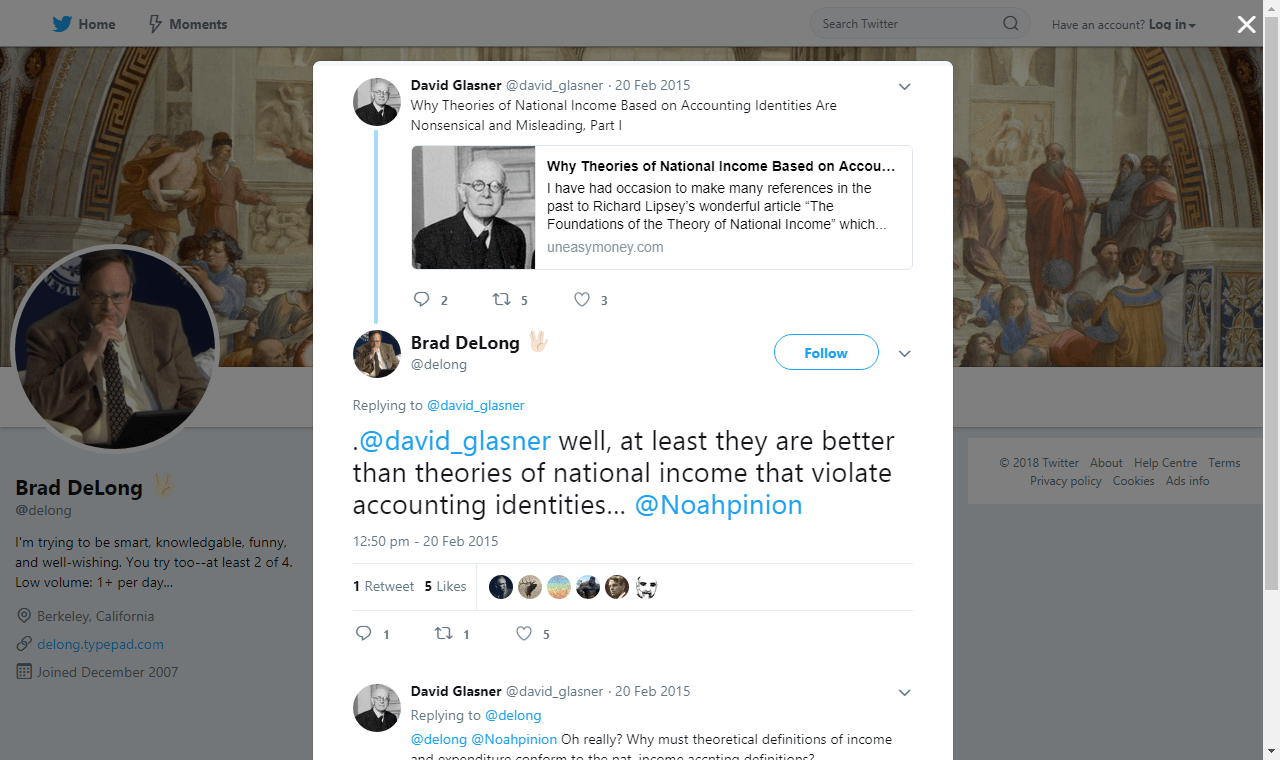What brings the supply and demand for money into equivalence?
It is interesting that the recent Bank of England quarterly bulletin referred to an article of Peter Howells, a Post-Keynesian (also available here), although I don’t think the authors appreciate why the paper is interesting.
The title of my blog post is flicked from a paper by Basil Moore which is in reply to Howells.
Howells sets up the problem:
[B]anks set up their collateral standard and lending rates … and then meet all loan requests forthcoming. The demand for loans is determined by other variables in the economic system … making the loan volume exogenous from the banks’ point of view and the resulting quantity of deposits endogenous … Notice, crucially that in this view, increases in the money supply are demand-determined but the demand in question is the demand for loans … the question then is what reconciles the demand resulting from this lending with peoples’ willingness to hold money? … What is it that ensures that the supply of new deposits created by the flow of net new lending is just equal to the quantity demanded?
Let me present it in another way. To be clear let us assume the economy is closed. Output is determined by domestic demand or by private expenditure and government expenditure. Output is equal to the national income and is distributed to various economic units such as households who among other things allocate a part of their wealth into deposits. So there is a money demand. Of course expenditure is partly from income and sale of existing assets and by borrowing from other economic units and in particular from banks which lend by creating deposits in this process. So there is a change in the money supply. So there are two pictures with overlapping stories but not exactly so the question is – what processes ensure that
Ms = Md
is valid at every instant of time?
Does the rise in income and higher demand for money (because of a rise in wealth) alone ensure this? Is there a price clearance? Prices of what? Goods and services? Or prices in financial markets? (‘price’ includes interest rates such as deposit rates, loan rates, bond yields, equity prices and so on).
Also note this is in nominal variables. So is the rise in income purely due to a rise in prices or purely a rise in real output or a mix of the two? What causes inflation?
Where does QE fit into this? Does it raise output? Real/nominal? Raise prices – of goods and services or asset prices or both?
It is important to appreciate the formulation of the question. In case you don’t yet appreciate the question, more from Howells:
The starting point is that the demand for the loans that create the deposits originates in the desire of deficit units to spend in exceess of income. It is a question of financing an income-expenditure discrepancy. Furthermore, it is a decision made by a subset of the community since not everyone is involved in demanding an increase in their indebtedness to banks. (Indeed it is not even the case that everyone holds a stock of bank debt…). By contrast, the decision to hold (i.e., not spend) the newly created deposits is a portfolio decision. Furthermore, it is a decision made by different people (“the community as a whole”) from those concerned with borrowing it… the fact remains that so long as we are dealing with two groups of agents, with different motives, an ex ante coincidence of preferences is quite implausible. The question, then, is how are these ex ante preferences to be reconciled, ex post.
Back to Moore’s paper. Moore summarizes possible solutions suggested by Howells:
… Howells considers four responses that have been proposed to his conundrum:
- Kaldor and Trevithic[k] – any excess money is automatically extinguished as a result of the repayment of bank debt.
- Chick – the income multiplier process will automatically increase the demand for active balances.
- Laidler – the buffer stock demand for money is a demand “on average” over a period of time, rather than a demand for a fixed stock at a moment of time.
- Moore – “convenience lending,” the rejection of an independent money demand curve, rooted in a “full-blooded rejection of the idea of equilibrium”: In a non-ergodic world, no meaning can be attached to the notion of a unique general equilibrium stock of money demanded.
Howells maintains that the above list offers “promising solutions” to the mechanism that reconciles net new lending to borrowers with the change in the demand for money for the wealth holders. But he concludes that “each … on its own is almost insufficient” for the “reconciliation. As a result, he proposes that variations in relative interest rates, “which can and do occur continuously, provide the key to the fine-tuning required by the balance-sheet identity” …
Frequently in such discussions the accommodative behaviour of the banking system is forgotten. So there is another mechanism as highlighted by Nicholas Kaldor in his book The Scourge Of Monetarism (Oxford University Press, 1982):
As it is, a highly developed banking system already provides such facilities on an ample scale, since it is prepared to accommodate the public’s changing demand between different types or financial assets by altering the composition of the banks’ assets or liabilities in a reverse direction. If the non-banking public wishes to switch its holding of gilts for interest-bearing bank deposits, the banks are ready to supply such deposits at the minimum of inconvenience, and at the same time to place their surplus funds into the gilts which were previously held by the public. Similarly the banks provide easy facilities to their customers for switching balances on current accounts into interest-bearing deposit accounts, or vice versa.
In general banks not only hold government bonds but also other kinds of securities such as mortgage-backed securities, agency debt and so on. In olden days, there was no securitization and banks would hold more government bonds which got substituted. (See the Fed’s H.8 weekly release for data on banks’ assets) [There’s a Geithner ppt which mentions this in one slide, anyone has a link?]
This point is an important one because here the reconciliation happens via changes in quantities. Remember it is not just loans which create deposits but also banks buying bonds from the non-banking system which create deposits.
The answers to these questions can be found systematically by using James Tobin’s asset allocation theory.
Let me mention some positions. At one end are Monetarists for whom the direction of causality is from money to other things. So there may be an excess of money and if so leads to higher expenditure and a hot potato process in which money supply and demand are brought into equivalence by rise in prices of goods and services. It can also lead to a rise in real output but the Monetarists emphasize the price aspect more. In addition they also distinguish between government expenditure and private expenditure and try to point out that the latter is more efficient and so on.
Looking at an economy as a moving picture, as expenditures increase, output rises and there is a rise in prices of goods and services and a rise in the stock of money. Monetarists look at coincident events and assign some strange causalities.
Moving beyond Monetarism, there’s also a view that the reconciliation of the supply and demand for money necessarily happens via a rise in interest rates on everything including bank loans leading to a crisis. Of course that it not true because beyond a point banks will reduce lending instead of offering loans at higher interest rates. Banks have their own animal spirits but this is via tightening credit standards, quality of collateral etc. Also this is not the only outcome because the process of lending and borrowing increases output and income and can stabilize debt ratios. Nonetheless, debts can move into unsustainable territories and financial crisis do happen, and when it happens, there’s a high demand for money and the reconciliation may happen via bankruptcies of firms and the central bank may need to accommodate the rise in demand for money by lending at a large scale since bankruptcies threaten a fall in output.
Of course there are many more mechanisms for the reconciliation which I have avoided. It may happen that due to changes in portfolio preferences, there is a stock market boom and firms will go IPO instead of borrowing from the banking system. So we have economic units who wish to hold less money and more equities and firms borrowing less from the banking system leading to a reconciliation. (A more careful analysis is needed because firms have deposits after having raised funds through an IPO).
Now consider convenience lending. There is of course some truth to it. If you receive you salary on a Friday evening, you are not rushing to allocate newly held deposits into the stock market because it is already closed (unless you have an international brokerage account). So you are holding the deposits non-volitionally. However, subscribing to convenience lending alone is a bit extreme.
Now to QE/LSAP. When the central bank purchases financial assets such as government bonds from the markets, it creates bank settlement balances and deposits in the process. Wealth holders will then purchase other assets and the reconciliation happens via changes in prices of financial assets.
This post is far from any complete analysis of the interesting questions but hopefully I have got readers interested in something. The question on reconciliation asks what reconciliates the demand and supply of money – income, prices (of goods and services or prices in financial markets), quantities and so on. Also, some seem to think that “price clearing” has to do with some notions about an equilibrium. I don’t think these two are the same things. One can have price changes and clearances without appealing to the notion of any “equilibrium”.

